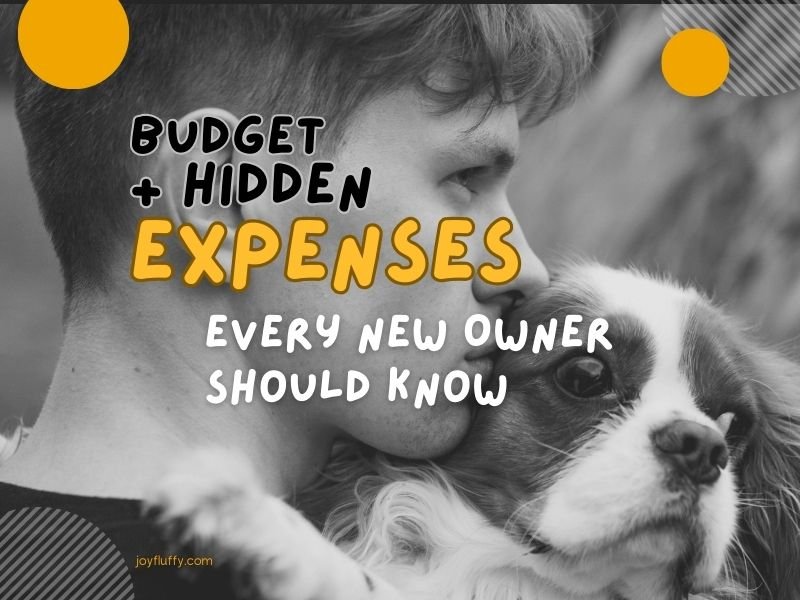Dog First-Year Costs — Budget & Hidden Expenses | JoyFluffy

Bringing a dog into your home is joyful — and it has real costs. Knowing the cost of owning a dog first year helps you prepare financially, choose the right supplies and care, and avoid stressful surprises if an emergency occurs. This guide walks through likely expenses, common hidden costs, and practical ways to lower your total outlay while keeping your new pet healthy and happy.
Why your first-year budget matters
The first 12 months combine many one-time expenses (adoption or purchase, spay/neuter, initial vet care, supplies) with recurring costs (food, preventive medications, grooming, training). Without a plan, an unexpected emergency or behavior problem can lead to debt or rushed decisions. Budgeting ahead gives you options: whether to buy insurance, build an emergency fund, or prioritize early training that prevents expensive problems later.
First-year cost breakdown (typical ranges)
These are approximate U.S. dollar ranges to help you build a realistic budget. Local prices, your dog’s breed, and whether you adopt or buy will change the totals.
- Adoption / purchase: $0 – $2,000+ (shelter adoption fees are usually modest; reputable breeders vary widely)
- Initial vet (vaccines, deworming, microchip, exam): $150 – $400
- Spay / neuter: $150 – $500
- Food (first year): $300 – $900 (depends on size and brand)
- Supplies (bed, crate, leash, bowls, toys): $150 – $600
- Training (group classes or private): $100 – $600
- Pet insurance (annual estimate): $200 – $700
- Misc. (grooming, license, treats): $100 – $400
Typical total first-year cost: $1,000 – $4,500+. Small dogs usually land toward the lower end; large breeds, specialty diets, or breeder puppies often push totals higher. Emergency surgeries or long-term treatment can push costs far beyond these ranges, so plan conservatively.
What the main categories cover (and why prices vary)
- Adoption vs. purchase: Shelters often include basic vaccines and may offer spay/neuter bundles in the adoption fee; breeders may charge more for pedigree and early care. If you’re comparing options, consult regional shelter resources for adoption procedures and included care.
- Vet care: Puppies need a series of vaccinations, parasite checks and at least one wellness exam; microchipping is inexpensive but essential for recovery if your dog gets lost. For general preventive-care guidance, the American Veterinary Medical Association is a reliable source: https://www.avma.org.
- Spay/neuter: Recommended for health and behavior benefits; low-cost clinics exist in many areas and are worth investigating.
- Food: A small dog on a budget brand may cost under $300/year; a large dog on premium food can exceed $900. Consider price-per-pound and the caloric needs of your dog’s size.
- Training: Early training prevents destructive habits. Group classes are generally more affordable; private trainers and behaviorists cost more but may be necessary for complex issues.
Hidden expenses that commonly surprise owners
- Emergency veterinary care: Accidents, bloat, poisoning or other urgent conditions can cost thousands. Emergency surgeries frequently fall in the $1,000–$5,000+ range.
- Behavioral treatment: Severe separation anxiety or aggression can require a certified behaviorist and ongoing sessions, which add up.
- Boarding and pet sitting: Travel care often costs $25–$75/day depending on service level, and costs multiply for long trips or special needs dogs.
- Household damage: Puppies chew and soil — replacing furniture or flooring adds unexpected bills.
- Long-term medication: Chronic conditions (e.g., allergies or endocrine disorders) create recurring prescription and follow-up costs.
How to lower first-year costs (practical tactics)
- Adopt if possible. Shelters typically include initial care and are more affordable than many breeder options — adoption also gives a home to an animal in need. The ASPCA has helpful resources on rehoming and adoption basics: https://www.aspca.org.
- Build an emergency fund. Aim for at least $1,000 saved to cover urgent vet bills; consider more if you adopt a large-breed puppy or a dog with known medical needs.
- Compare pet insurance carefully. If you want protection against catastrophic bills, compare accident-only vs. comprehensive plans and read exclusions and waiting periods. Insurance can smooth unpredictable costs but isn’t the right choice for every household.
- Buy smart: use food subscriptions to save, buy non-consumable supplies second-hand (cribs, carriers, some beds), and compare price-per-pound for kibble.
- Invest early in training and prevention. Group classes and consistent training routines reduce the risk of destructive behavior and rehoming. For trustworthy training tips and breed-specific considerations, the American Kennel Club offers many practical articles: https://www.akc.org.
- Learn basic grooming and first aid. Brushing, occasional bathing and simple nail trims at home reduce salon costs and keep your dog healthier.
Sample first-year budgets by dog size (quick guide)
- Small dog: $1,000 – $1,800
- Medium dog: $1,500 – $2,200
- Large dog: $2,000 – $3,500+
Final checklist before bringing your dog home
- Decide adopt vs buy and include that cost in your plan.
- Set up a $1,000 emergency fund (increase for large-breed or high-risk dogs).
- Buy basic supplies before arrival to avoid last-minute markups.
- Schedule an initial vet visit within the first week.
- Research local trainers and boarders; note pricing and availability.
- Bookmark AVMA, ASPCA, and AKC resources for ongoing guidance (links above).
About this article (E-E-A-T)
This guide was written by a JoyFluffy editorial author using owner averages, veterinary guidance and consumer cost references to provide clear, experience-based advice. It is not a substitute for individualized veterinary or financial guidance — for specific medical or behavioral concerns consult a licensed veterinarian or certified trainer.
Frequently Asked Questions (FAQ)
Q: How much does a dog cost in the first year on average?
A: Typical first-year costs range from about $1,000 to $4,500 or more depending on adoption vs purchase, breed size, vet care and whether emergencies occur. Use the categories above to estimate your own total.
Q: What are the biggest unexpected expenses?
A: Emergency veterinary care, behavioral treatment, boarding/pet sitting, and household damage (chewed furniture) are common hidden costs owners forget to budget for.
Q: Is pet insurance worth it in the first year?
A: Pet insurance can help protect against large, unexpected bills. Its value depends on coverage, deductible, waiting periods and your willingness to self-insure. Compare plans carefully before purchasing



